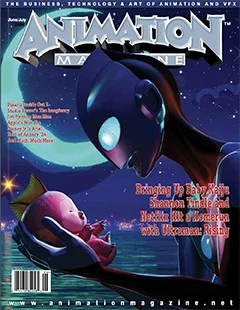|
Getting your Trinity Audio player ready...
|
“In today’s increasingly disconnected world, we must pay attention to what we are ignoring, what we are not seeing — always with moderation, respect and tolerance,” said Yoshiaki Nishimura, the acclaimed producer of Studio Ponoc’s new feature, The Imaginary. “We must remember what we see is not everything to be seen; we must look for what we cannot see and try to see as others do. We need to reflect on the thoughts of others, their anger and sadness, using our human imagination to perceive what truly drives their choices. As wars and conflicts continue and even grow around the world, the need to reflect on the invisible thoughts of others is precisely why we drew the boy no one can see.”
Based on a 2014 juvenile novel by English poet and author A.F. Harrold, The Imaginary is the latest feature from Studio Ponoc, the Tokyo-based animation shop founded by Nishimura nine years ago and the producer behind such works as Mary and the Witch’s Flower (2017) and Modest Heroes (2018). Directed by Yoshiyuki Momose, the film centers on Rudger, a boy who is the imaginary companion of Amanda Shuffleup, an adolescent girl who lives with her widowed mother in a contemporary British city. Although no one can see the blond boy except Amanda, they share the exciting adventures that spring from her polychrome imagination. Their pleasant existence is threatened by the appearance of the sinister Mr. Bunting, the only adult who can see Rudger — and who wants to devour him.
‘In this era when people are disconnected, we must be willing to try to see with our own eyes what is important to those we tend to avoid and try to understand what matters to them.’
— Producer Yoshiaki Nishimura
While fleeing Mr. Bunting, Amanda is struck by a car. As she’s unconscious, Rudger is left on his own in a parallel world inhabited by a bizarre assortment of Imaginaries whose children outgrew and forgot them. They assemble after hours in a library — a veritable temple of the imagination — but Rudger refuses to accept the rules they live by. He insists he must get back to Amanda, who may still awaken.
Nishimura and Momose discussed the film, which screened in competition at the Annecy Festival and premiering on Netflix in July, in a recent interview conducted via email. Both artists are veterans of Studio Ghibli, and Momose reflected on the influence of the studio’s directors on The Imaginary, which combines everyday reality with fantasy adventures.

Inspired by the Masters
“Watching Isao Takahata and Hayao Miyazaki create films, I was impressed by their understanding of the strengths and weaknesses of animation: They were able to visualize their work in a way that only animation could realize,” said the director. “I found tremendously interesting and influential on me their process of conceiving and expressing images based on reality, then seeking the right amount of deformation in the drawings and finally bringing it all to another level of expression that could only be achieved through animation.”
Nishimura and Momose kept the story’s British setting, as its premise seemed incompatible with Japanese popular culture. “I briefly thought about moving the story to Japan. But the concept of imaginary friends is not widespread in Japan,” Nishimura explained. “If the story were set in Japan, many Japanese viewers would probably perceive imaginary friends as supernatural beings, like ghosts and goblins. This would have fixed The Imaginary into the realm of mere cinematic rhetoric rather than the realistic story I sought to tell.”
![The Imaginary [Studio Ponoc / Netflix]](https://www.animationmagazine.net/wordpress/wp-content/uploads/The-Imaginary_rgr09_026_t01.0098_cropped_300dpi.jpg)
“Rudger has a personality entirely separate from Amanda, the girl who imagined him, yet he’s also Amanda herself,” Nishimura adds. “This sets our film apart from many stories of growing up through nonhuman beings in which there is a clear self and a clear ‘other.’ I admired Harrold’s insight as a poet to take on the challenge of portraying such an interesting story from the viewpoint of the ‘imaginary friend.’ I was also excited that this story would allow us to embed, metaphorically, important themes that are relevant only to us adults.”
Some of the most challenging scenes to create in the film take place in the library, where scores of Imaginaries gather, seeking shelter. Every morning, they vie for job assignments that allow them to entertain and perhaps become the regular friend of another child. Although there are dozens of characters, no two look alike or move in the same way, a problem most Western studios would have used CG to tackle.
“The library scenes show that Imaginaries inhabit not only the inner lives of children but exist as themselves and as a community in a dimension only slightly shifted from human society,” says Momose. “Each Imaginary has a look that reflects the sensibility of the child who imagined it, so each has a unique design. The reason why there are so many Imaginaries is I wanted the audience to relate to at least some of them and feel that Imaginaries are right there, next to the viewer, even though they cannot be seen. The scenes teeming with Imaginaries were time-consuming and difficult, but there was no easy way out.”
“The Imaginaries have distinctive looks, which leads some viewers to incorrectly conclude they were computer-generated, but none of them were,” he continues. “They’re all hand-drawn with help in some cases from computer tools. The process of adding special textures and three-dimensional effects to the hand-drawn animation was something we had never done before. Again, it was time-consuming and difficult, but [it] was worth it and we’re satisfied with the outcome.”
Rudger cannot adapt to life in the library; the temporary assignments the other Imaginaries vie for hold no interest for him. He remains focused on finding Amanda: If he can help her awaken from her coma, they can be together again. The real world is an alien place for him, frightening in its unknown complexities. If something bothered him during their shared adventures, Rudger just asked Amanda to change it — which she could easily do. But he braves the real streets to search for his companion.
The greatest threat he faces is not the unknown people he passes as they go about their daily business — they can’t see him — but the creepy Mr. Bunting. In Harrold’s book, Mr. Bunting devours Imaginaries, gaining energy and strength from their essence. Rudger, who incorporates the sorrows of Amanda’s life as well as her joyful creativity, is especially attractive to Mr. Bunting. The filmmakers show him trying to inhale Rudger, similar to the way the Dementors attack in the Harry Potter films.
“Mr. Bunting swallowing Imaginaries was in the original novel, and along with his companion, the black-haired girl, they give an extremely scary impression,” says Momose. “We added geometric patterns to the inside of Mr. Bunting’s mouth and treated it like a black hole. I believe that this effect also highlights the difference in the dimensions of existence because Mr. Bunting eats Imaginaries, not humans.”
![The Imaginary [Studio Ponoc / Netflix]](https://www.animationmagazine.net/wordpress/wp-content/uploads/The_Imaginary_u_00_09_13_13_R2-1.jpg)
Vanishing Souls
Reflecting on the completed film, Nishimura returns to the need to understand others and their points of view, however different: “When I started The Imaginary, I was confident that it was in tune with our times, not because many things in the world are becoming virtual due to information technology, but because of the opposite. Our world is increasingly fragmented and isolated, with the number of invisible — unseen — things and people continuing to grow. It is an unfortunate fact that our world, vaunted for such easy access to everything and everyone, is paradoxically working not to render us visible but to render us invisible.”
“Algorithms are not adept at containing us within the one world we actually can see and direct our attention and interest outside of ourselves,” he concludes. “In this era when people are disconnected, we must be willing to try to see with our own eyes what is important to those we tend to avoid and try to understand what matters to them. It is precisely because we cannot see the future that we are able to have hope, but we are also anxious. I thought The Imaginary could present the question of what would make us strong enough to move forward.”
The Imaginary premieres on Netflix on July 5.
The English-language voice cast features Louie Rudge-Buchanan as Rudger, Evie Kiszel as Amanda, Jeremy Swift as Mr. Bunting, Hayley Atwell, Sky Katz, Kal Penn, LeVar Burton, Jane Singer, Ruby Barnhill, Roger Craig Smith, Courtenay Taylor and Miles Nibbe.
Animation Magazine will present a free, advance screening of the film, followed by a Q&A this Sunday, June 23 at Netflix’s Tudum Theater in Los Angeles. Details here.




![THE IMAGINARY - Studio Ponoc's The Imaginary will premiere on Netflix later this year. Cr: Netflix © 2024 Ponoc The Imaginary [Studio Ponoc / Netflix]](https://www.animationmagazine.net/wordpress/wp-content/uploads/The-Imaginary_rgr01_045_t01.0001_cropped_300dpi-696x377.jpg)


![The Imaginary [Studio Ponoc / Netflix]](https://www.animationmagazine.net/wordpress/wp-content/uploads/The-Imaginary_rgr01_013_t02.0744_Netflix_Jan_12_2023.0.jpg)
![The Imaginary [Studio Ponoc / Netflix]](https://www.animationmagazine.net/wordpress/wp-content/uploads/The-Imaginary_270140.jpg)
![The Imaginary [Studio Ponoc / Netflix]](https://www.animationmagazine.net/wordpress/wp-content/uploads/The-Imaginary_rgr04_004_t02.0097-1.jpg)
![The Imaginary [Studio Ponoc / Netflix]](https://www.animationmagazine.net/wordpress/wp-content/uploads/The-Imaginary_Environment-Shot.jpg)
![The Imaginary [Studio Ponoc / Netflix]](https://www.animationmagazine.net/wordpress/wp-content/uploads/The-Imaginary_ta_main3_sp-170x240.jpg)








